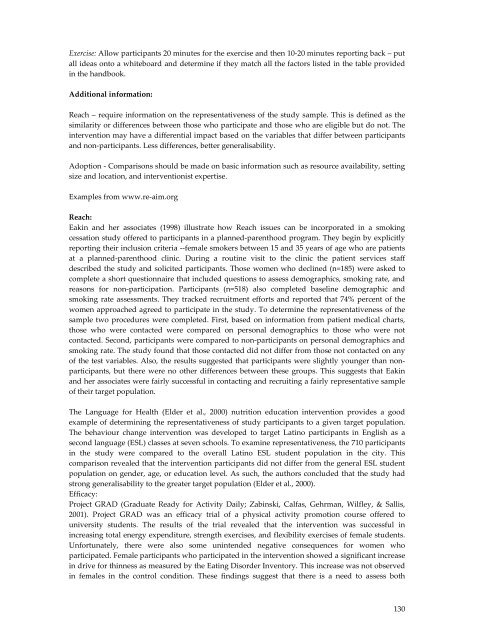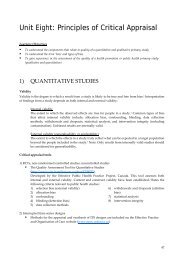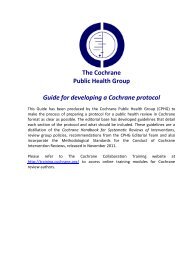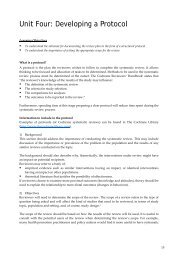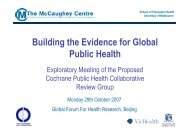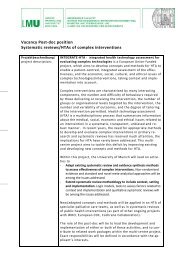Train the Trainer Course book - Cochrane Public Health Group
Train the Trainer Course book - Cochrane Public Health Group
Train the Trainer Course book - Cochrane Public Health Group
You also want an ePaper? Increase the reach of your titles
YUMPU automatically turns print PDFs into web optimized ePapers that Google loves.
Exercise: Allow participants 20 minutes for <strong>the</strong> exercise and <strong>the</strong>n 10-20 minutes reporting back – put<br />
all ideas onto a whiteboard and determine if <strong>the</strong>y match all <strong>the</strong> factors listed in <strong>the</strong> table provided<br />
in <strong>the</strong> hand<strong>book</strong>.<br />
Additional information:<br />
Reach – require information on <strong>the</strong> representativeness of <strong>the</strong> study sample. This is defined as <strong>the</strong><br />
similarity or differences between those who participate and those who are eligible but do not. The<br />
intervention may have a differential impact based on <strong>the</strong> variables that differ between participants<br />
and non-participants. Less differences, better generalisability.<br />
Adoption - Comparisons should be made on basic information such as resource availability, setting<br />
size and location, and interventionist expertise.<br />
Examples from www.re-aim.org<br />
Reach:<br />
Eakin and her associates (1998) illustrate how Reach issues can be incorporated in a smoking<br />
cessation study offered to participants in a planned-parenthood program. They begin by explicitly<br />
reporting <strong>the</strong>ir inclusion criteria --female smokers between 15 and 35 years of age who are patients<br />
at a planned-parenthood clinic. During a routine visit to <strong>the</strong> clinic <strong>the</strong> patient services staff<br />
described <strong>the</strong> study and solicited participants. Those women who declined (n=185) were asked to<br />
complete a short questionnaire that included questions to assess demographics, smoking rate, and<br />
reasons for non-participation. Participants (n=518) also completed baseline demographic and<br />
smoking rate assessments. They tracked recruitment efforts and reported that 74% percent of <strong>the</strong><br />
women approached agreed to participate in <strong>the</strong> study. To determine <strong>the</strong> representativeness of <strong>the</strong><br />
sample two procedures were completed. First, based on information from patient medical charts,<br />
those who were contacted were compared on personal demographics to those who were not<br />
contacted. Second, participants were compared to non-participants on personal demographics and<br />
smoking rate. The study found that those contacted did not differ from those not contacted on any<br />
of <strong>the</strong> test variables. Also, <strong>the</strong> results suggested that participants were slightly younger than nonparticipants,<br />
but <strong>the</strong>re were no o<strong>the</strong>r differences between <strong>the</strong>se groups. This suggests that Eakin<br />
and her associates were fairly successful in contacting and recruiting a fairly representative sample<br />
of <strong>the</strong>ir target population.<br />
The Language for <strong>Health</strong> (Elder et al., 2000) nutrition education intervention provides a good<br />
example of determining <strong>the</strong> representativeness of study participants to a given target population.<br />
The behaviour change intervention was developed to target Latino participants in English as a<br />
second language (ESL) classes at seven schools. To examine representativeness, <strong>the</strong> 710 participants<br />
in <strong>the</strong> study were compared to <strong>the</strong> overall Latino ESL student population in <strong>the</strong> city. This<br />
comparison revealed that <strong>the</strong> intervention participants did not differ from <strong>the</strong> general ESL student<br />
population on gender, age, or education level. As such, <strong>the</strong> authors concluded that <strong>the</strong> study had<br />
strong generalisability to <strong>the</strong> greater target population (Elder et al., 2000).<br />
Efficacy:<br />
Project GRAD (Graduate Ready for Activity Daily; Zabinski, Calfas, Gehrman, Wilfley, & Sallis,<br />
2001). Project GRAD was an efficacy trial of a physical activity promotion course offered to<br />
university students. The results of <strong>the</strong> trial revealed that <strong>the</strong> intervention was successful in<br />
increasing total energy expenditure, strength exercises, and flexibility exercises of female students.<br />
Unfortunately, <strong>the</strong>re were also some unintended negative consequences for women who<br />
participated. Female participants who participated in <strong>the</strong> intervention showed a significant increase<br />
in drive for thinness as measured by <strong>the</strong> Eating Disorder Inventory. This increase was not observed<br />
in females in <strong>the</strong> control condition. These findings suggest that <strong>the</strong>re is a need to assess both<br />
130


